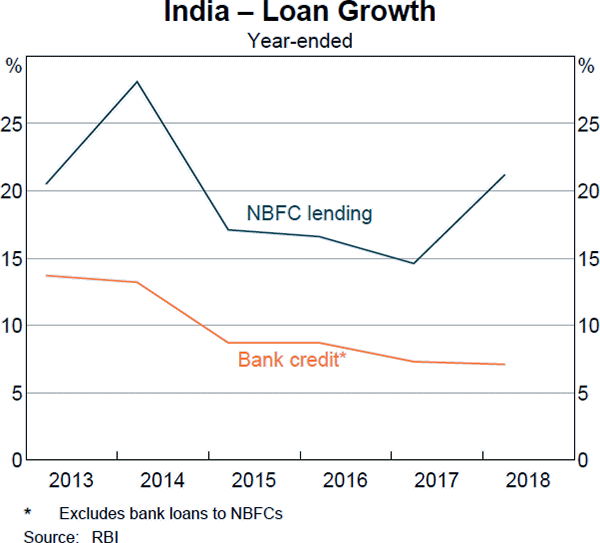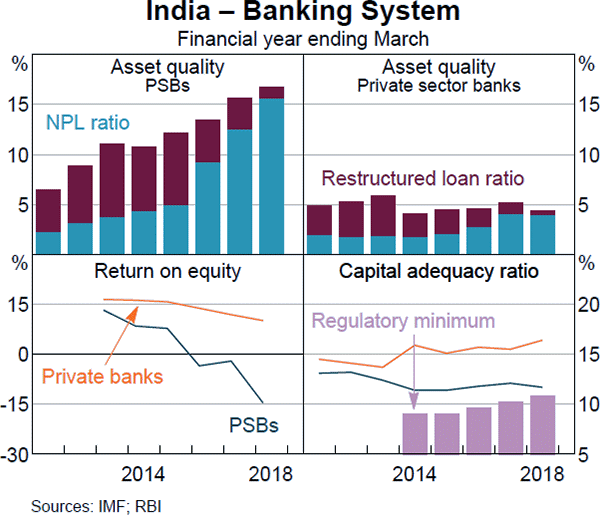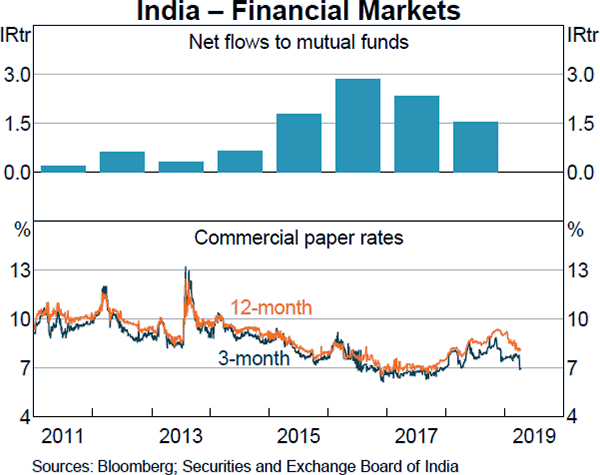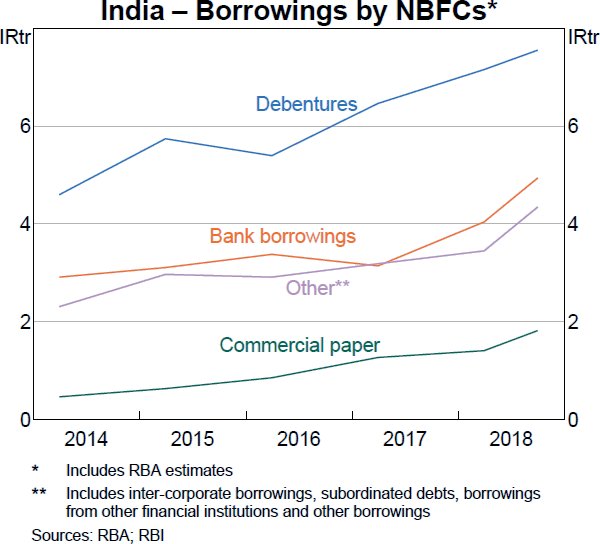Financial Stability Review – April 2019 Box A: Risks in Non-bank Lending in India
In India risks related to non-bank lenders have increased over a number of years with some risks crystallising in 2018. Rapid lending growth by non-bank lenders had coincided with reduced credit supply from public sector banks that had significant increases in non-performing loans (NPLs). Non-bank lenders provide a source of competition in the financial sector, and diversify risks away from banks. However, non-bank lenders are subject to less stringent regulation and supervision. This can result in weaker lending standards, higher borrower leverage and the build-up of credit and liquidity risks within the financial system.
The default of a large, high-profile non-bank lender in the second half of 2018 highlighted these risks. This resulted in a significant tightening in financial conditions for the non-bank sector. Prompt action by the Indian authorities mitigated contagion risks and helped to restore market confidence. Other initiatives by policymakers, non-bank lenders and banks to improve the resilience of the Indian financial system continue to be implemented.
Banks dominate the Indian financial sector …
Banks dominate lending in India, but non-bank lenders are also key suppliers of credit and other financing. Banks account for almost two-thirds of total financial system assets, with public sector banks (PSBs) owning around 60 per cent of banking system assets.
Non-bank lenders have assets equivalent to around 20 per cent of the financial system. Within this, non-bank financial companies (NBFCs) account for almost 70 per cent of non-bank lending, with the remainder accounted for by housing finance companies, primary dealers and mutual funds. The market share of NBFCs has been growing in recent years and there are now around 10,000 NBFCs. But most of the NBFC sector's assets are owned by nearly 300 ‘systemically important’ non-deposit-taking NBFCs (those with assets larger than IR5 billion, or roughly A$100 million).[1] As with the banking sector, the Indian Government has ownership stakes in several NBFCs, which together account for 30 per cent of the sector's assets. NBFCs focus mainly on lending for infrastructure, commercial real estate and equipment (including cars). NBFCs are interconnected with the banking system as much of their funding comes from bank loans, supplemented with wholesale funding. The Reserve Bank of India (RBI) regulates both NBFCs and banks, although different regulatory regimes apply.[2]
… but bank lending has been constrained in recent years
Lending by NBFCs has grown rapidly. Over the past five years, lending growth by NBFCs has averaged 20 per cent, double that of bank lending (Graph A1). With this, the share of total credit provided by NBFCs has risen to more than 15 per cent in 2017, up from around 10 per cent in 2007. NBFCs have been able to grow their lending rapidly as lending by PSBs has been constrained. A significant rise in bad debts at PSBs over much of past decade led the RBI to require PSBs to clean up their balance sheets, which weighed on their capacity to lend.

The PSBs' financial stress emerged out of a decade-long boom in private infrastructure investment in India, beginning in the mid 2000s.[3] PSBs were very active in funding this spending, as well as expansions in the mining and steel sectors. However, they weakened lending standards, which, combined with cost over-runs on many projects, led to a significant deterioration in the asset performance of PSBs.[4] NPLs and restructured loans rose sharply at the PSBs, in contrast to private banks (Graph A2). In turn, this put considerable pressure on PSBs' profitability and capital positions.

Growing financial stress at PSBs resulted in numerous policy measures over several years. The RBI tightened prudential rules on asset classification and provisioning;[5] imposed sanctions, including lending restrictions, on weak banks (mainly PSBs); [6] and conducted an asset quality review of major banks (including all PSBs). The Indian Government injected capital into the PSBs and implemented measures to improve PSB governance.[7] A new insolvency and bankruptcy regime was introduced, together with new powers for the RBI to force large NPLs to be resolved through insolvency.[8]
These measures increased NPL transparency, strengthened the regulatory framework more generally, and facilitated the clean-up of banks' balance sheets, especially at the PSBs. However, the improved recognition of banks' large stock of bad debts weighed heavily on their profits and capital. Together with the lending restrictions on the weakest banks, this resulted in a pronounced slowdown in bank lending.
Partly as a result, non-bank lending grew rapidly
NBFCs were well positioned to capitalise on PSBs' reduced lending as it coincided with increased availability of cheap funding. In 2016, the government of India withdrew the legal tender status of the country's two highest denomination banknotes to address counterfeiting and promote the formal financial system over the use of cash. This led to a sharp increase in the assets under management of mutual funds (Graph A3). This in turn led to increased investment by mutual funds in debentures and commercial paper (including that issued by NBFCs). Short-term interest rates fell.[9] Accordingly, NBFCs were able to materially increase their short-term wholesale borrowing, at relatively low interest rates, to increase their lending (Graph A4).[10]


But vulnerabilities also rose …
However, the boom in lending resulted in a buildup of vulnerabilities in the NBFCs, including:
- increased credit risks from lending mainly to real estate and infrastructure companies for long and complex projects, which had earlier weighed on PSBs. Some credit assessment and monitoring was undermined by firms' complicated corporate structures and perceptions of implicit guarantees, such as for firms backed by government-related entities.
- higher liquidity and interest rate risks, from greater use of short-term wholesale debt to fund longer-term loans.
- higher contagion risks in the financial system, because wholesale funding is mainly provided by other financial institutions.
… and some of them crystallised last year, causing liquidity conditions to tighten
Some of these risks materialised last year. In June, a high-profile infrastructure-focused NBFC and some of its subsidiaries began defaulting on bank loans and short-term debt obligations. The defaults by Infrastructure Leasing & Financial Services (IL&FS) followed poor returns on major projects, in an environment of rising interest rates. The IL&FS group had total debt of IR910 billion (almost A$20 billion) at the time of the defaults.
The defaults came as a surprise to many investors, partly because the firm had high credit ratings from local ratings agencies and prominent shareholders (including several large Indian banks and well-known foreign institutional and corporate investors). With the company having a significant quantity of bonds outstanding – reportedly 3 per cent of the Indian corporate bond market – the defaults quickly led to a deterioration in investor sentiment. In particular, concerns mounted about the creditworthiness of other NBFCs. Share prices for listed NBFCs fell by over 20 per cent in the following months. There were significant outflows from fixed income mutual funds that lend to NBFCs. Commercial paper rates increased and issuance volumes declined.
Active policy responses helped to quickly stabilise conditions
IL&FS's financial distress, and potential failure, threatened to trigger a broader liquidity crunch for NBFCs. This could have led to further NBFC failures, asset fire sales and potentially distress across the financial system, interrupting the flow of credit to the real economy. In recognition of these risks, Indian policymakers took a range of actions to stabilise funding conditions.
The RBI injected a large quantity of liquidity into the financial system. It also took steps to encourage banks' support for NBFCs, including by allowing banks to provide partial guarantees for bonds issued by NBFCs. The government replaced the entire board of IL&FS. The new board started selling assets and formulating plans for other recovery measures to repay the company's debt – such as capital injections by existing or new shareholders and the sale of subsidiaries. The government obtained a court order granting a temporary stay on legal proceedings by creditors against the company, giving it time to restructure.
Other NBFCs have sought to strengthen their balance sheets by selling assets via securitisation. To support this, the RBI has temporarily relaxed the minimum holding period requirement for certain NBFC loans before they can be securitised. The RBI has also tried to encourage overseas borrowing by infrastructure firms. Rules on external borrowing were eased, in terms of both tenor and hedging requirements.
Actions by policymakers and NBFCs have reduced the acute uncertainty that arose during late 2018. Money market interest rates have declined, inflows to mutual funds have resumed, investor sentiment has recovered and commercial paper issuance has picked up. Some NBFCs have started to lengthen the term of their liabilities to reduce their asset-liability maturity mismatch. Nonetheless, funding conditions for NBFCs remain tighter than before the defaults.
The RBI has strengthened its earlier efforts to bring regulatory rules on NBFCs broadly into line with those for banks. In particular, the RBI has signalled its intention to address asset-liability maturity mismatches at NBFCs. This is expected to slow the growth of credit facilitated by NBFCs. However, this could be offset by increased lending from PSBs as the RBI has started lifting lending restrictions on some PSBs, while the government is continuing to inject new capital.
Footnotes
For more details, see Reserve Bank of India (2018), ‘Chapter VI: Non-banking Financial Institutions’, Report on Trend and Progress of Banking in India 2017–18, pp 117–119. [1]
The RBI also regulates primary dealers, while housing finance companies are regulated by the National Housing Bank, a subsidiary of the RBI. Mutual funds are regulated by the Securities and Exchange Board of India. [2]
For more details on this boom, see Chong S and E Poole (2013), ‘Financing Infrastructure: A Spectrum of Country Approaches’, RBA Bulletin, September, pp 65–76. [3]
See Mundra S (2015), ‘Indian Banking Sector: Emerging Challenges and Way Forward’, Lecture organised by State Bank of Mysore, Bangalore, 29 April. [4]
For more details, see IMF (2017), ‘Financial System Stability Assessment for India’. [5]
Under the Prompt Corrective Action (PCA) framework. For more details, see Archarya V (2018), ‘Prompt Corrective Action: An Essential Element of Financial Stability Framework’, Speech at the Indian Institute of Technology, Mumbai, 12 October. [6]
The first plan announced in mid 2015 envisaged a capital injection of IR1.8 trillion, with the government providing one-third of the funds (and the rest sourced from private investors and asset sales). A second recapitalisation plan was announced in late 2017, worth around IR2.1 trillion, with two-thirds coming from the government. More recently, the government obtained parliamentary approval to inject a further IR400 billion into PSBs. [7]
To speed up default resolution, in February 2018, the RBI also instructed banks to begin insolvency proceedings for large corporate clients within 180 days of the first missed payment, unless an agreed resolution plan was in place. Recently, the Indian Supreme Court ruled that the RBI did not have the power to issue these industry-wide instructions (but could compel banks to take such action on a case-by-case basis). [8]
For more details, see RBI (2017), ‘Impact of Demonetisation on the Financial Sector’, RBI Bulletin, November, pp 7–20. [9]
For more details, see RBI (2018), ‘Box VI.1: What Explains the Robust Credit Growth of NBFCs?’, Report on Trend and Progress of Banking in India 2017–18, pp 121–122. [10]